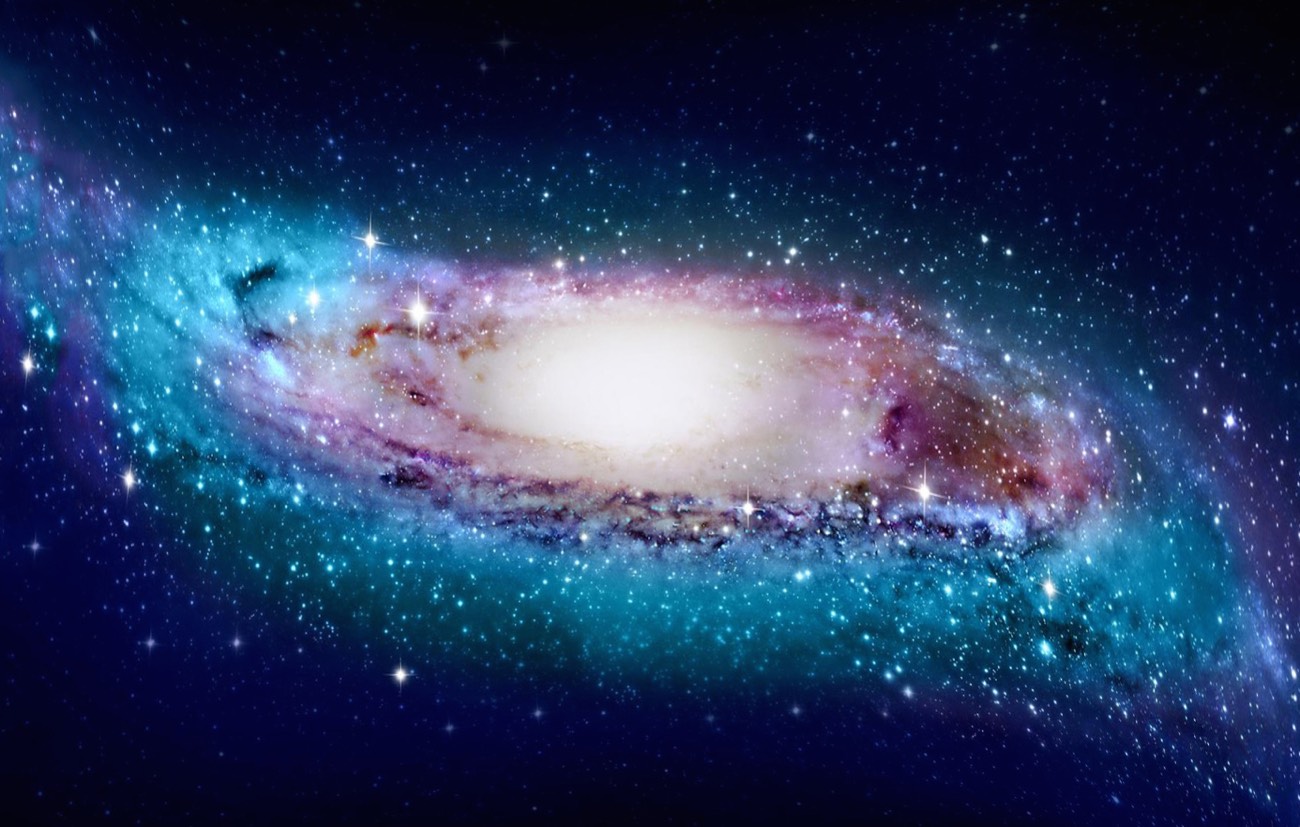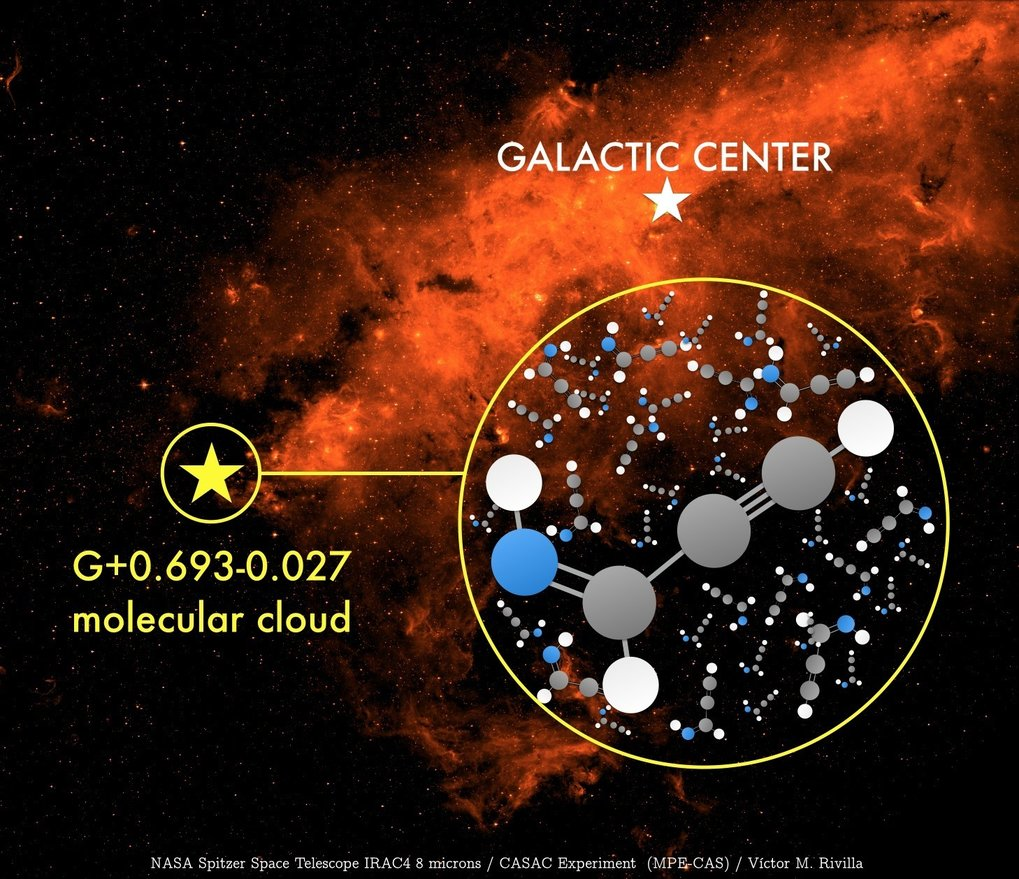Discovered organic molecules that can make life in the center of the Milky Way
Near the center of the Milky Way, in a huge cloud of interstellar dust, astronomers discovered an organic molecule that had never appeared in outer space. Named propargylamine, it could be a key ingredient in the formation of amino acids, one of the most important things in the history of life.
' The strangeness of this chemical lies in their carbon-nitro double bonds, making them highly reactive ,' said Luca Bizzocchi, an astrophysicist at the Max Planck Institute for Alien Physics, for good.
' With this double bond, it becomes an important element in the chemical chain that leads to the formation of the simplest, most abundant molecules of the universe containing carbon and nitro - such as formaldehyde (H2CO) or ammonia ( NH3) - up to complex things like amino acids, the building blocks of ground biology '.

Illustration of the Milky Way.
The scientists found this organic molecule in a system of molecular gas clouds, called the Central Molecular Zone (G + 0.693-0.027), a space that is inherently still catch the eye of industry experts. It contains many complex organic molecules in the Universe such as ethyl formate, iso-propyl cyanide and propylene oxide.
The above substances are prebiotics, which play an important role in creating 'building blocks of life' such as amino acids, RNA and DNA. As Bizzocchi said, propargylamines may play an important role in shaping the aforementioned elements of life; Specifically, the carbon-nitro double bonds play a large role in a chemical reaction called Strecker synthesis - the method of creating amino acids in the laboratory environment.
In addition, propargylamine also has a structure similar to some organic molecules that have been confirmed to exist in extraterrestrial space. So Bizzocchi and his team decided to find it. First, they need to understand propargylamine in the lab environment first.

Propargylamine in cluster G + 0.693-0.027.
When light penetrates a cloud of molecules, the molecules in it absorb and redistribute electronic radiation at a certain wavelength, each producing different wavelengths. We can think of this as the 'fingerprints' of organic molecules, and in order to 'solve the case', scientists have to know what the fingerprints look like.
' When molecules rotate in space, they emit light photons at specific frequencies. By combining this information with data from radio telescopes, we know if the molecule exists in the dust cloud , '' explained the researcher Bizzocchi.
Obtaining a fingerprint from the lab, and then comparing it to the observed telescope results, they made an interesting discovery in the Central Molecular Area.
' [Organic molecules] are among the G + 0.693-0.027 data, only we cannot identify them when the spectrum is unknown - the signaling framework - emanating from them. As soon as we got the missing information, it was because of the lab measurements that we immediately realized propargylamine was waiting for someone to discover it, '' said researcher Víctor M. Rivilla from the Institute of Physics. Italian National Astronomy said.
Who knows in the vast universe out there, what else doesn't have a 'fingerprint' waiting for humans to discover?
You should read it
- The interaction between the Milky Way and a satellite galaxy is creating many new stars
- Fastest star in the Milky Way, speed 8,226,967 km/h
- Astronomers discovered a 'candy cane' in the center of the Milky Way
- Galaxy merger moment gives glimpse into Milky Way's future
- Do you think the Sun stands still and the Earth revolves around it? Just wrong!
- Find strong evidence of life on Mars
- Germany successfully created the 'black hole' in the molecule with the world's most powerful X-ray beam
- The future of computing lies in organic molecules?
May be interested
- Swiss researchers found new organic luminescent material
 the newly discovered luminescent material is cheap, efficient and can become an alternative light source in the future.
the newly discovered luminescent material is cheap, efficient and can become an alternative light source in the future. - Do you think the Sun stands still and the Earth revolves around it? Just wrong!
 many people believe that the sun is the center of the universe, it stands still and other planets like earth, venus, mars ... orbit around it. so what about reality? please read the following article to get the most accurate answer.
many people believe that the sun is the center of the universe, it stands still and other planets like earth, venus, mars ... orbit around it. so what about reality? please read the following article to get the most accurate answer. - See stunning works from the art of capturing miniatures with the Milky Way
 thanks to photography, you can 'freeze' a great moment of time, a breathtaking view and share it with everyone.
thanks to photography, you can 'freeze' a great moment of time, a breathtaking view and share it with everyone. - It turns out this is how the galaxy Milky Way formed 13.5 billion years ago
 a new technology map that simulates the way the milky way galaxy formed in the universe over tens of billions of years ago is making the global astronomers flutter.
a new technology map that simulates the way the milky way galaxy formed in the universe over tens of billions of years ago is making the global astronomers flutter. - Breakthrough: The first discovery of an oxygen molecule outside the Milky Way
 recent studies by astronomers mark an important milestone that helps decipher the formation of oxygen molecules in galaxies.
recent studies by astronomers mark an important milestone that helps decipher the formation of oxygen molecules in galaxies. - The reasons for Data Center crash
 data operators sometimes make mistakes that can lead to the data center being stopped. however, most of these incidents can be avoided through maintenance measures, testing procedures and by the feeling and experience of system operators.
data operators sometimes make mistakes that can lead to the data center being stopped. however, most of these incidents can be avoided through maintenance measures, testing procedures and by the feeling and experience of system operators. - The mysterious bubble that appears in the center of the Milky Way galaxy is finally 'decoded'.
 since its first discovery to date, the fermi bubble has caused astronomers around the world to have a 'headache' for not being able to find the origin of this giant gamma-ray structure.
since its first discovery to date, the fermi bubble has caused astronomers around the world to have a 'headache' for not being able to find the origin of this giant gamma-ray structure. - Revealing new findings about the size of the galaxy
 this discovery provides valuable insights into the structure and characteristics of the milky way.
this discovery provides valuable insights into the structure and characteristics of the milky way. - NASA discovers second Milky Way galaxy at the edge of the solar system
 the mysterious region of space that nasa's voyager spacecraft are heading to may contain strange replicas of the milky way's 'arms'.
the mysterious region of space that nasa's voyager spacecraft are heading to may contain strange replicas of the milky way's 'arms'. - Discover the longest giant marine species ever recorded
 scientists have recorded images of the longest marine species ever discovered.
scientists have recorded images of the longest marine species ever discovered.










 Australia discovered dinosaur fossils turned into gems
Australia discovered dinosaur fossils turned into gems Decipher the mystery behind a photo of a 'human bone' object on NASA's Martian surface
Decipher the mystery behind a photo of a 'human bone' object on NASA's Martian surface The weirdest place on the planet: Where the compass points in one direction and more
The weirdest place on the planet: Where the compass points in one direction and more Scientists create the world's best heat-resistant material, which can be used for spacecraft
Scientists create the world's best heat-resistant material, which can be used for spacecraft Why do whales swing their tails up and down, but sharks swing their tails to the sides?
Why do whales swing their tails up and down, but sharks swing their tails to the sides? New research shows Tyrannosaurus Tyrannosaurus relies on her sixth sense to 'love'?
New research shows Tyrannosaurus Tyrannosaurus relies on her sixth sense to 'love'?